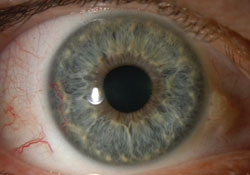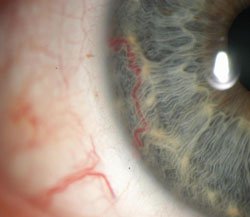Patient referred for iris lesion in right eye
There were no associated visual changes.
 Priti Batta |
 Namrata Nandakumar |
A 48-year-old man was referred to the New England Eye Center’s anterior segment service for the evaluation of a peculiar iris lesion in the right eye. The patient had no complaints with his visual acuity and denied having eye pain or discomfort. He had no past ocular problems and no medical problems.
On examination, the patient’s uncorrected visual acuity was 20/20 in both eyes. His confrontational visual fields, extraocular movements and pupillary reactions were all normal. His IOP measured 17 mm Hg in both eyes. External exam was normal.
Slit lamp biomicroscopy of the right eye demonstrated the iris lesion shown in Figures 1a and 1b. A very subtle irregularity in the pupil margin could be detected. There were no areas of iris atrophy. Dilated episcleral vessels were noted in the 8 o’clock meridian. Slit lamp biomicroscopy of the left eye was normal. Gonioscopic examination revealed a normal angle structure without vascular invasion or peripheral anterior synechiae. Dilated fundus examination at the slit lamp and with indirect ophthalmoscopy revealed normal retinal and vascular findings.
|
|
|
|
Figures 1a (left) and 1b (right). Slit lamp
biomicroscopy showed the iris lesion in the right eye. A very subtle
irregularity in the pupil margin could be detected.
Images: Lazzara M, Hu D |
|

What is your diagnosis?
Iris lesion
Our patient had an iris lesion in the right eye, with a prominent dilated episcleral vessel in the same vicinity. The major categories of diseases to consider in such a scenario are malignant tumors, benign tumors or vascular lesions. Specific disorders to consider in the differential diagnosis include melanoma, iris varix, iris capillary hemangioma, iris cavernous hemangioma and iris arteriovenous malformation.
An iris varix is generally a solitary, more rounded lesion that involves a vein and does not have a dilated feeding artery. Iris capillary hemangiomas are redder and can be either a more diffuse or a more circumcised mass. Iris cavernous hemangiomas appear as small grapelike tufts at the pupillary border. Iris melanoma is typically a solid mass that may have prominent visible vascularity. Ciliary body melanoma can present with a dilated prominent sentinel episcleral vessel or have an extension of the lesion through the sclera that presents as a bluish hue in the vicinity.
All patients with suspected iris or ciliary body lesions should have gonioscopy, dilated fundus examination, and an A/B scan or ultrasound biomicroscopy (UBM) to rule out a malignant process. In addition to normal gonioscopy and dilated fundus exam, UBM was performed on this patient. No thickening of the iris stroma was noted, and there were no discreet anterior uveal vascular or solid masses seen.
Discussion
Discovery of prominent iris vessels is generally an ominous sign of a significant vascular disease process that is likely manifesting in the posterior segment (eg, proliferative diabetic retinopathy, central retinal vein occlusion). Uveal tumors localized to the iris or ciliary body can induce dilation of vessels in nearby structures. Less commonly found are isolated iris vascular lesions, without posterior disease or local tumor, such as the one discovered here.
While the existence of isolated iris vascular lesions was once questioned, more recent reviews have clearly documented distinct characteristics of five unique benign tumors: iris capillary hemangioma, iris cavernous hemangioma, iris microhemangioma, iris arteriovenous malformation (racemose hemangioma) and iris varix. The most frequently encountered complication is spontaneous hyphema. However, some may have significant systemic associations.
The single, tortuous, dilated vessel seen snaking from the iris root, through the iris stroma and arching back in this patient is most consistent with an iris arteriovenous malformation. Iris arteriovenous malformations are likely congenitally abnormal connections between veins and arteries. Iris stromal atrophy within the vascular arch can sometimes be seen, and in about half of patients, regional episcleral vessel dilation or a “sentinel” vessel can be found. As with all iris lesions, a close examination looking for distortion of the pupil margin, stromal thickening or dislocation, and angle involvement is warranted. Often, UBM is employed to exclude an otherwise occult ciliary body lesion. In cases in which the irregular vessels are obscured by normal iris tissue, an anterior segment fluorescein angiogram can be done to further characterize the abnormality.
The two lesions that can flag more significant systemic findings are iris cavernous hemangiomas and iris microhemangiomatosis (or microhemangiomas). Iris cavernous hemangiomas appear as multilobular (grape-like) blue/red iris stromal masses and can be associated with central nervous system hemangiomas or, in young patients, with diffuse congenital hemangiomatosis. Iris microhemangiomas, meanwhile, present as small vascular tufts generally found solely along the pupil margin and can be difficult to distinguish from neovascularization. Interestingly, these lesions can be seen in myotonic dystrophy and may have some link with diabetes mellitus.
Follow-up
Our patient was seen for follow-up at 6 months and continued to do well with an absence of any symptoms. No changes were noted in the appearance of the lesion. A repeat UBM was unchanged and showed no variation in the regional iris insertion and ciliary body. No further treatment is indicated, and the patient will continue to be followed yearly. If a recurrent hyphema were to occur, successful treatment with laser photocoagulation has been reported.
References:
- Broaddus E, Lystad LD, Schonfield L, Singh AD. Iris varix: report of a case and review of iris vascular anomalies. Surv Ophthalmol. 2009;54(1):118-127.
- Shields JA, Bianciotto C, Kligman BE, Shields CL. Vascular tumors of the iris in 45 patients: the 2009 Helen Keller Lecture. Arch Ophthalmol. 2010;128(9):1107-1113.
- Shields JA, Streicher TF, Spirkova JH, Stubna M, Shields CL. Arteriovenous malformation of the iris in 14 cases. Arch Ophthalmol. 2006;124(3):370-375.
- Matthew Lazzara, MD, and Daniel Hu, MD, can be reached at New England Eye Center, Tufts University School of Medicine, 800 Washington St., Box 450, Boston, MA 02111; 617-636-4219; fax: 617-636-4866; website: www.neec.com.
- Edited by Priti Batta, MD, and Namrata Nandakumar, MD. Drs. Batta and Nandakumar can be reached at New England Eye Center, Tufts University School of Medicine, 800 Washington St., Box 450, Boston, MA 02111; 617-636-4219; fax: 617-636-4866; website: www.neec.com.



